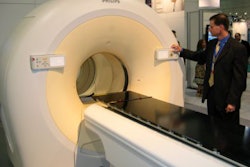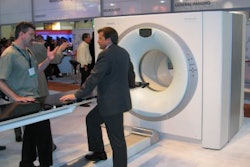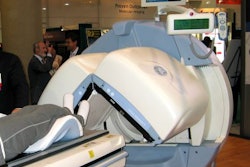SAN DIEGO - While it's common knowledge that obesity is linked to a greater risk for a fatal cardiac event, FDG uptake in the aorta of an overweight patient may serve as a marker for atherosclerosis, according to a presentation this week at the 2006 Society of Nuclear Medicine (SNM) meeting.
The study was led by Dr. Wichana Chamroonrat from the Hospital of the University of Pennsylvania in Philadelphia, and builds on previous research out of the University of Pennsylvania (UPenn). In 2002, investigators assessed FDG uptake in the abdominal aorta (AA), iliac (IA), and proximal femoral arteries (FAs) in 156 patients, some of whom had atherogenic risk factors including age, diabetes, high cholesterol, and obesity.
They found a significant difference in the frequency of FDG uptake between those without risk factors (22%) and those with risk factors (70%) in the FA and the IA (30% versus 54%). Among all risk factors, age was the most significant and consistent factor correlating with FDG uptake in all three arteries, the group reported (Seminars in Nuclear Medicine, January 2002, Vol. 32:1, pp. 70-76).
For the current study, 47 patients (mean age of 57 years) who underwent FDG-PET imaging for other clinical reasons were included. The 60-minute PET studies on a whole-body Allegro scanner (Philips Medical Systems, Andover, MA) were done after an injection of 5.2 MBq/kg of FDG.
Total cholesterol, low-density lipid, and triglyceride levels were confirmed within six months of the FDG-PET study, and blood glucose levels were recorded just before the FDG-PET study. Height and weight were recorded on the day of the study, and the body mass index (BMI) scores stratified the patients into three groups:
- Twelve subjects were normal weight (NW < 25) with an average blood glucose level of 99 ± 10 mg/dL.
- Sixteen subjects were overweight (OW = 25-29) with an average blood glucose level of 100 ± 18 mg/dL.
- Nineteen subjects were obese (OB ≥ 30) with an average blood glucose level of 95 ± 15 mg/dL.
"In each patient, the maximum standardized uptake value (SUV) of FDG in four regions of the aortic wall (ascending, arch, and descending thoracic aorta, and abdominal aorta) were measured and the lean body mass was used to determine the corrected SUV (SUVIbm)," the authors explained. The ANOVA test was done to compare results between the two groups.
The results showed that increases in SUVIbm in separate regions of the aorta were correlated with an incremental rise in BMI.
The aorta in obese subjects was metabolically more active than those of normal weight, the authors concluded. As a result, FDG uptake in the aorta may play a role in determining potential risk for a cardiovascular event.
In a related SNM paper, another UPenn group found that 3D time-of-flight (TOF) imaging could improve the diagnostic accuracy of PET/CT regardless of a person's size and weight.
For this phantom study, measurements were performed on a preproduction unit of the Gemini PET/CT scanner (Philips Medical Systems) with TOF capability. These measurements were used to quantify the improvement with TOF of hot and cold sphere contrast recovery (CRC), background noise, and detectability as a function of object size and count statistics.
According to their results, "TOF information led to a faster convergence to maximum CRC with the iterative reconstruction algorithm." In addition, lower noise value compared to non-TOF reconstruction was achieved. Finally, lesion detectability improved as timing resolution improved with greater gains in larger phantoms.
Lead author Dr. Suleman Surti stated that "the current generation of PET scanners is limited in the quality of images produced for those patients who are overweight. This new TOF scanner will improve the diagnostic accuracy of images … in heavy patients, who have traditionally been difficult to image. This new technology can also reduce scan times for small- and average-size patients without losing diagnostic accuracy."
By Shalmali Pal
AuntMinnie.com staff writer
June 7, 2006
Related Reading
Echocardiography more difficult and less accurate in obese patients, May 30, 2006
Cholesterol, antioxidants may maintain bone, curb osteoporosis, May 15, 2006
Obesity linked to lower risk of cardiac death in CAD, April 6, 2006
ACAT inhibition may be harmful for coronary atherosclerosis, March 23, 2006
Copyright © 2006 AuntMinnie.com



















